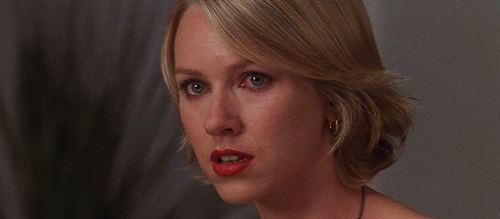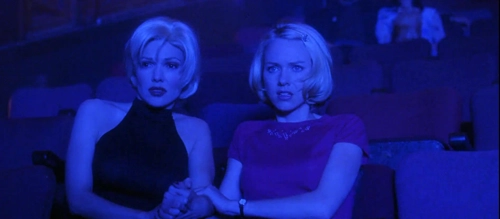Mulholland Drive (2001) Review

Mulholland Drive (2001)
Director: David Lynch
Screenwriter: David Lynch
Starring: Naomi Watts, Justin Theroux, Laura Elena Harring, Ann Miller, Robert Forster
Hollywood is a land of dreams: a mythic, romanticized vision that is inherently created and marketed through any film. The dazzling lights, gorgeous populace, and beautiful wardrobes distract from the underpaid workers and sleazy executives. David Lynch’s Mulholland Drive in some way contends with the duality of Los Angeles while offering a movie that is art before anything else, expressing a style that is more about creating meaning than profit. What makes Lynch’s text so rich is its true lack of answers for the curious, engrossed, and puzzled viewer.
David Lynch has a penchant for the unsettling, displaying classic Americana by the dark underside of the American subconscious. Lynch’s dreamlike, fantastical quality to (most of) his work is on full display in Mulholland Drive, creating a mystery that can be endlessly debated. An enigmatic mosaic, it follows an aspiring actress named Betty who attempts to help her new acquaintance, Rita, discover her identity. Alongside this story is a cynical tale from Hollywood about a director being strong-armed by the industry, not being allowed to make his film the way he wants. Along the way there are car crashes, waking nightmares, Persona allusions, a Spanish stage show, and a cowboy.
Disorientation is the goal of the film’s visual style, helping to craft the illusion of a dream. Scenes are framed in uncanny ways – for example, a scene around a table is shot with two people in the lower left corner with a large gap in the right of the frame. A character enters the space to serve an espresso, giving the space a functional purpose, but overall affecting the expectation that film mimics reality. The editing (by Mary Sweeney) works towards this goal as well, with abundant juxtapositions and discomforting choices. These cinematic touches play into the film’s themes of Hollywood and what is and is not real through media representations of the industry by betraying the traditional principles of film style.
Sound, a staple of Lynch’s creation of atmosphere, is used to its full potential in Mulholland Drive. Based on the costume stylings, this film appears to take place contemporaneously, but the use of jazzy music evokes a more nostalgic, postwar era. The movement from whimsy into horror is often marked by disturbing ambient noise that creeps up subtly. Sound is disconnected from reality in a scene at a club where the music playing is mimed as a tape plays the audio, creating a bizarre experience for the characters and viewers alike.

The performances do often help ground the film, giving a solid impression of characters that may be more symbolic than “real”. Naomi Watts’ Betty is an archetype of a wide-eyed young person coming to the big city to make it in the movies. She is plucky and optimistic, but can really turn it on and give the performance of a lifetime during an audition. Laura Herring gives a powerful performance as the amnesiac Rita, embodying a classical actress affectation even when she hasn’t a clue what is going on. Every side performance adds exciting color to the film, as Lynch knows how to use his stable of weird and magnetic actors to add to the mood of any given scene. One standout is Monty Montgomery’s performance as the philosophical enforcer cowboy, who goes toe-to-toe with Justin Theroux’s director character to make sure the will of the studio executives is followed.
Whatever narrative exists in the film is nonlinear and possibly entirely fictitious within its own diegetic space. Some believe the film to be entirely reality, others entirely dream, and some a mix of the two. There are plenty of signs and symbols that can point to when is what, but there’s no guarantee David Lynch even knows or cares. What story is there is a mystery that might captivate but is more likely to leave you questioning every given turn as nothing is satisfactorily resolved. That philosophy lends to the idea of dreams, as they can often be disjointed, but could also point to a mediocre or poorly planned suspense movie plot that Rita and Betty are characters in? These are the questions that help make Mulholland Drive an enduring watch, as nothing is truly answered while the components of the story can be enjoyed on scene-by-scene merits because each moment is fascinating.
Two scenes that point to potential authoritative interpretations are complete oddities that seem like non-sequiturs in the story. The first involves two men sitting in a diner, where one accounts a dream in which he is horrified as the two stand in the same diner. Slowly the actions of the dream begin to take place, and the man recounting his dream wanders outside to find if the horrifying figure from his dreams is present. Later, Betty and Rita visit Club Silencio, where they are treated to the illusory stage show that leads to the pair (with matching hair) to weep. There are portions of the film that are surely dreams because of the narrative and character representation in contrast with other parts. But some scenes may represent a sort of reality – it would be amazing if the hilarious scene where a hitman messes up a faked suicide like an amateur Agent 47 is a real presentation of this guy in the film’s “real” diegetic Hollywood. Yet the presentation of a hitman is so ostentatious and more frequently an element of fiction than everyday reality.
Dreams, alternate realities, a commentary on the film industry – however you want to examine or interpret Mulholland Drive, its state as art is solidified through its expert craft and pieces that provoke the audience. No one will walk away from the film with no thoughts on it, even if one thinks it is entirely pointless and impenetrable. David Lynch can offer viewers a window into our dreams, fears, and souls. We’re presented with a visual representation of all the things swimming around in our heads. It creates perception and myth for any person. Mulholland Drive is Davis Lynch’s masterwork in cinema, solidifying him as one of the great masters of surrealism.
Score: 22/24
Recommended for you: Where to Start with David Lynch

